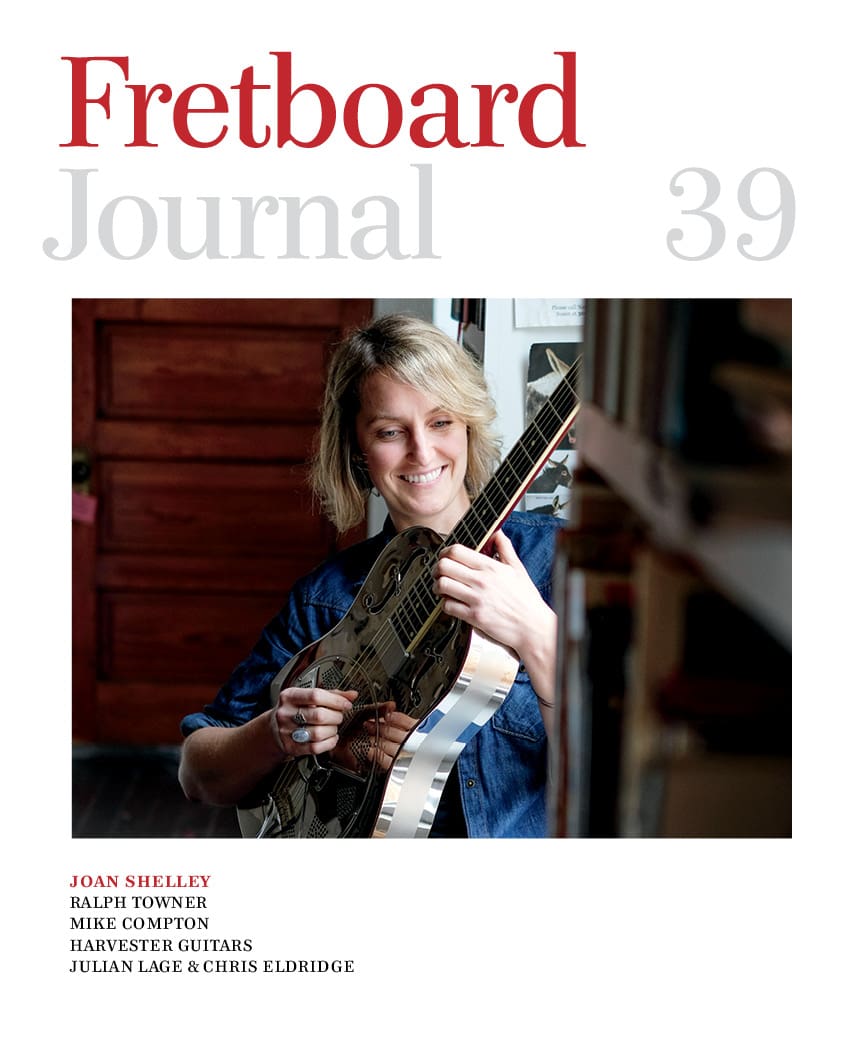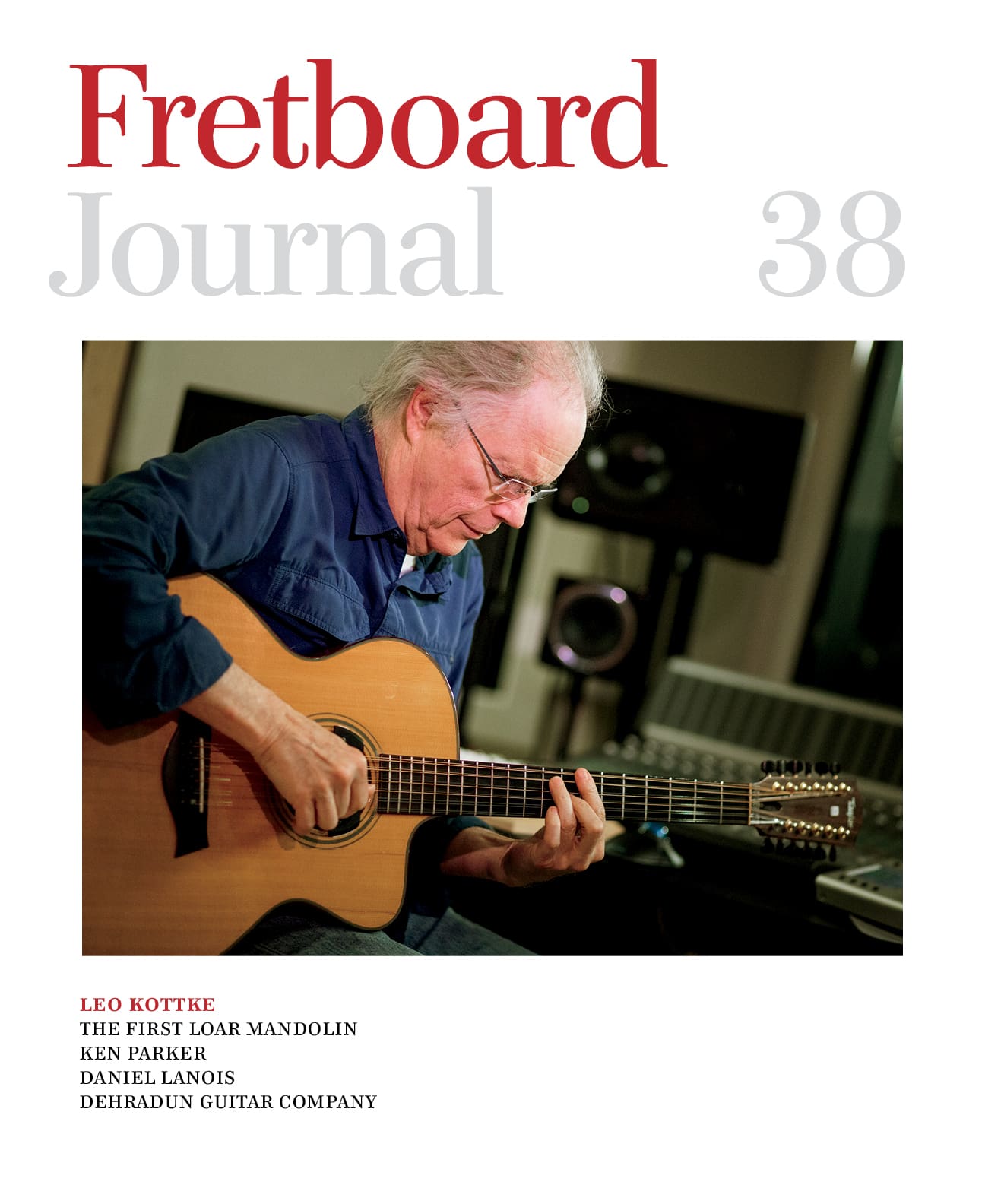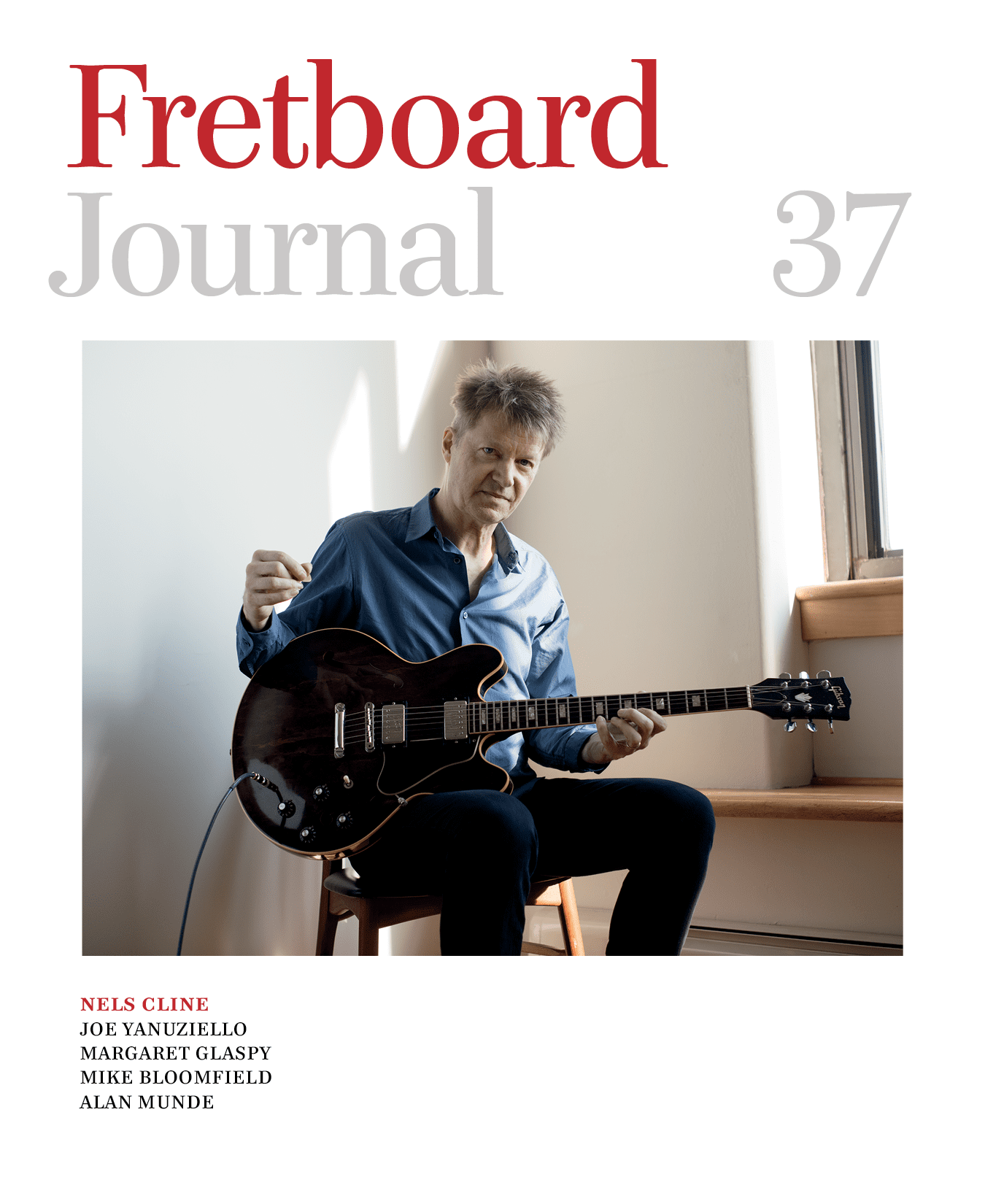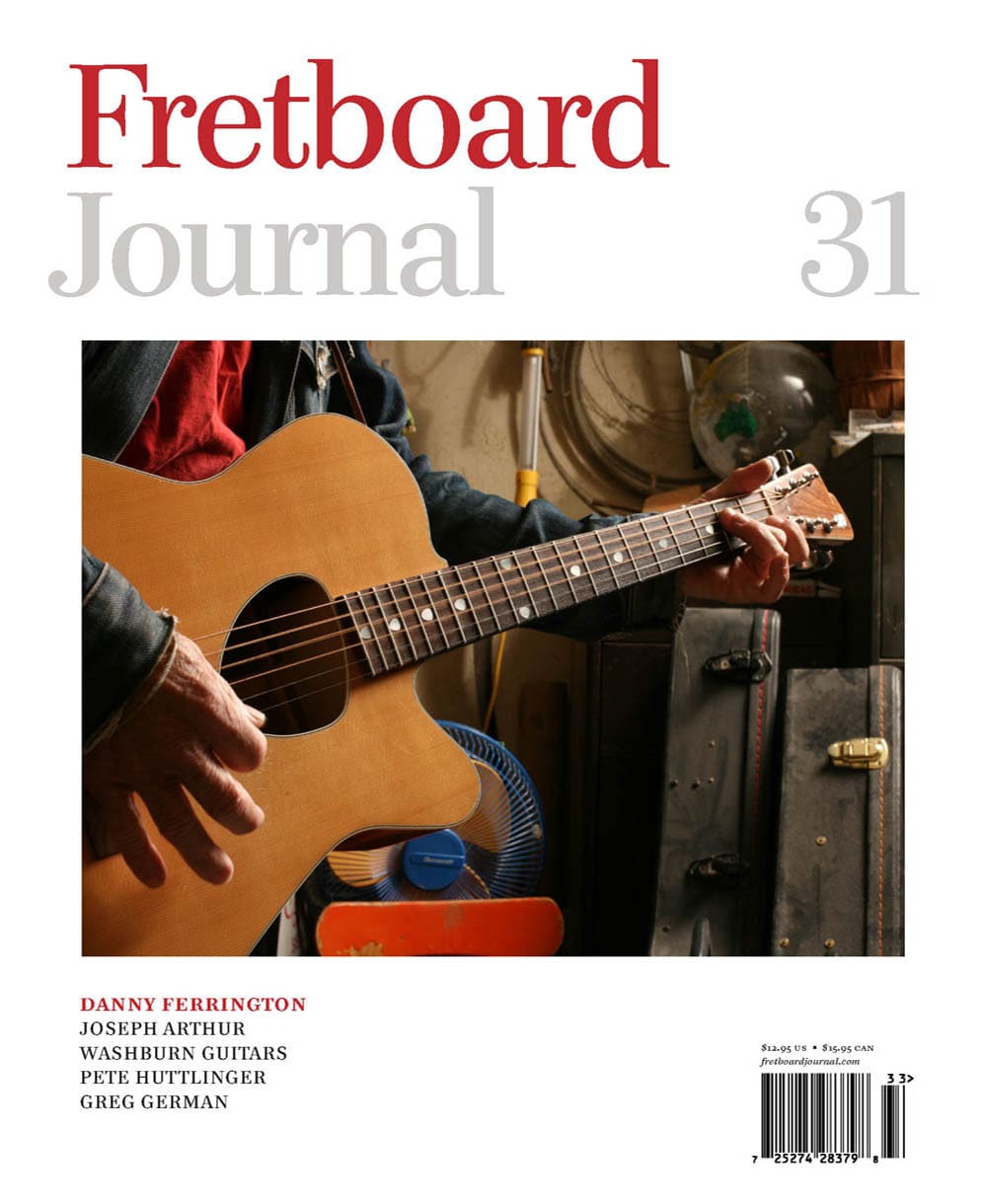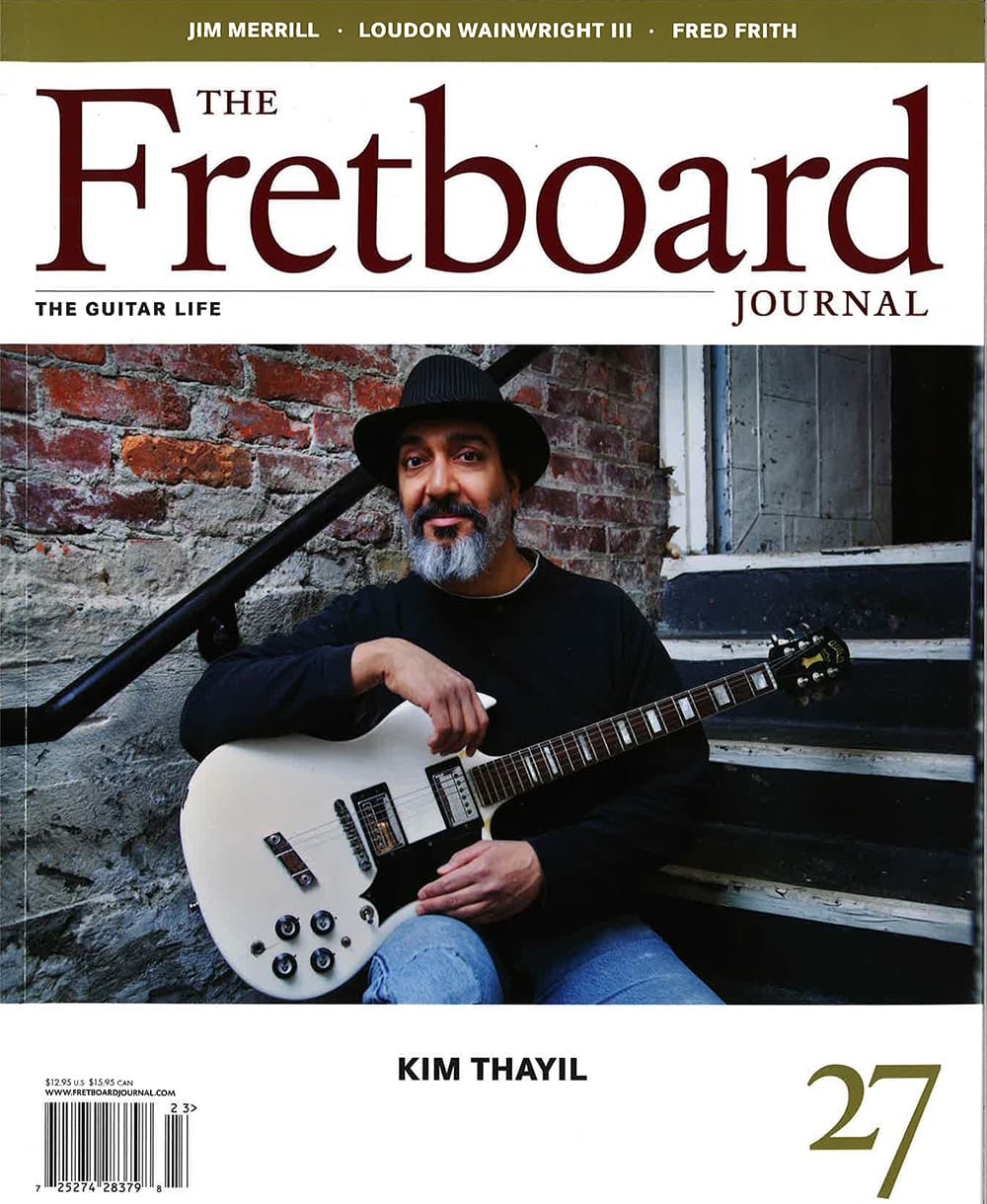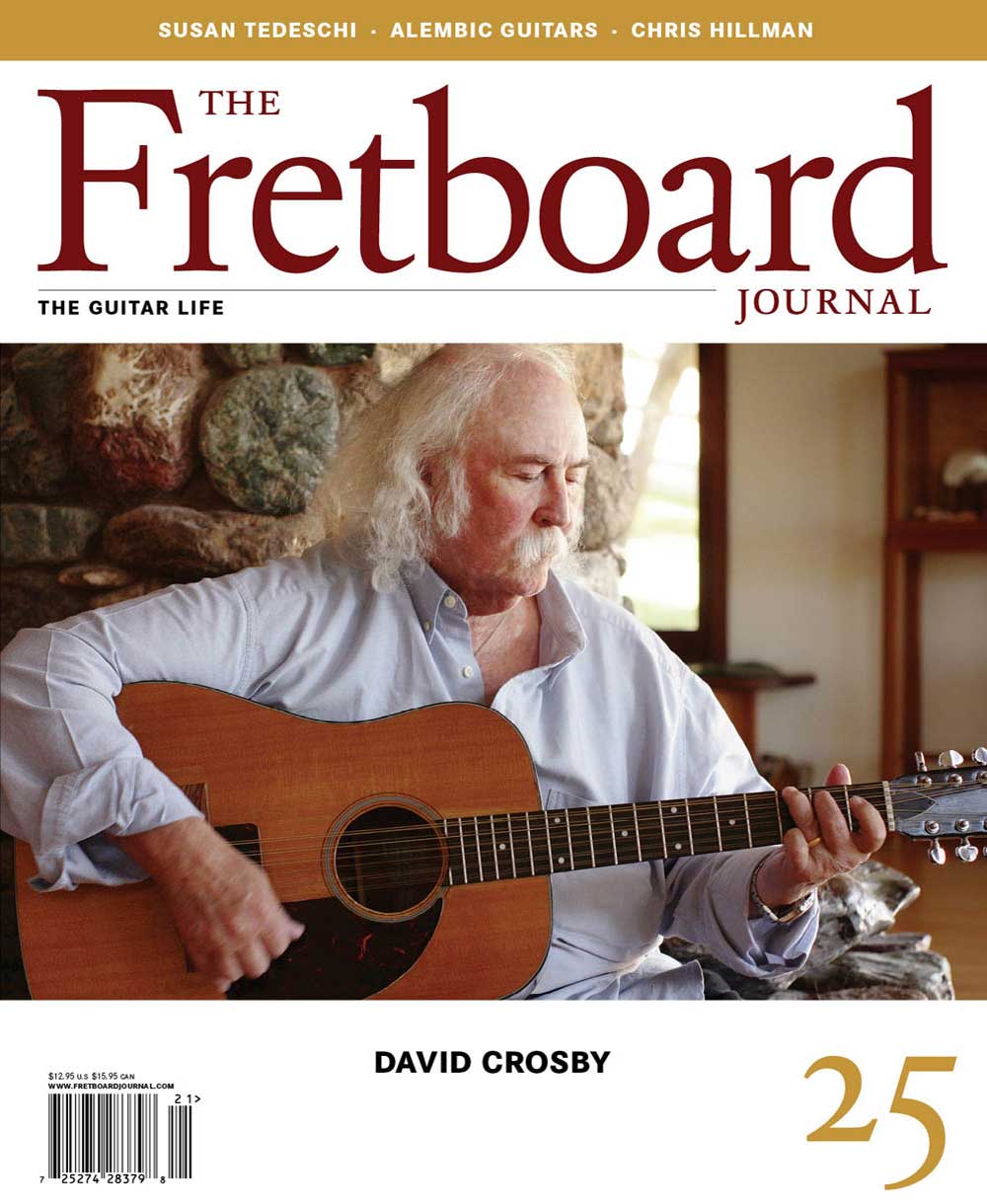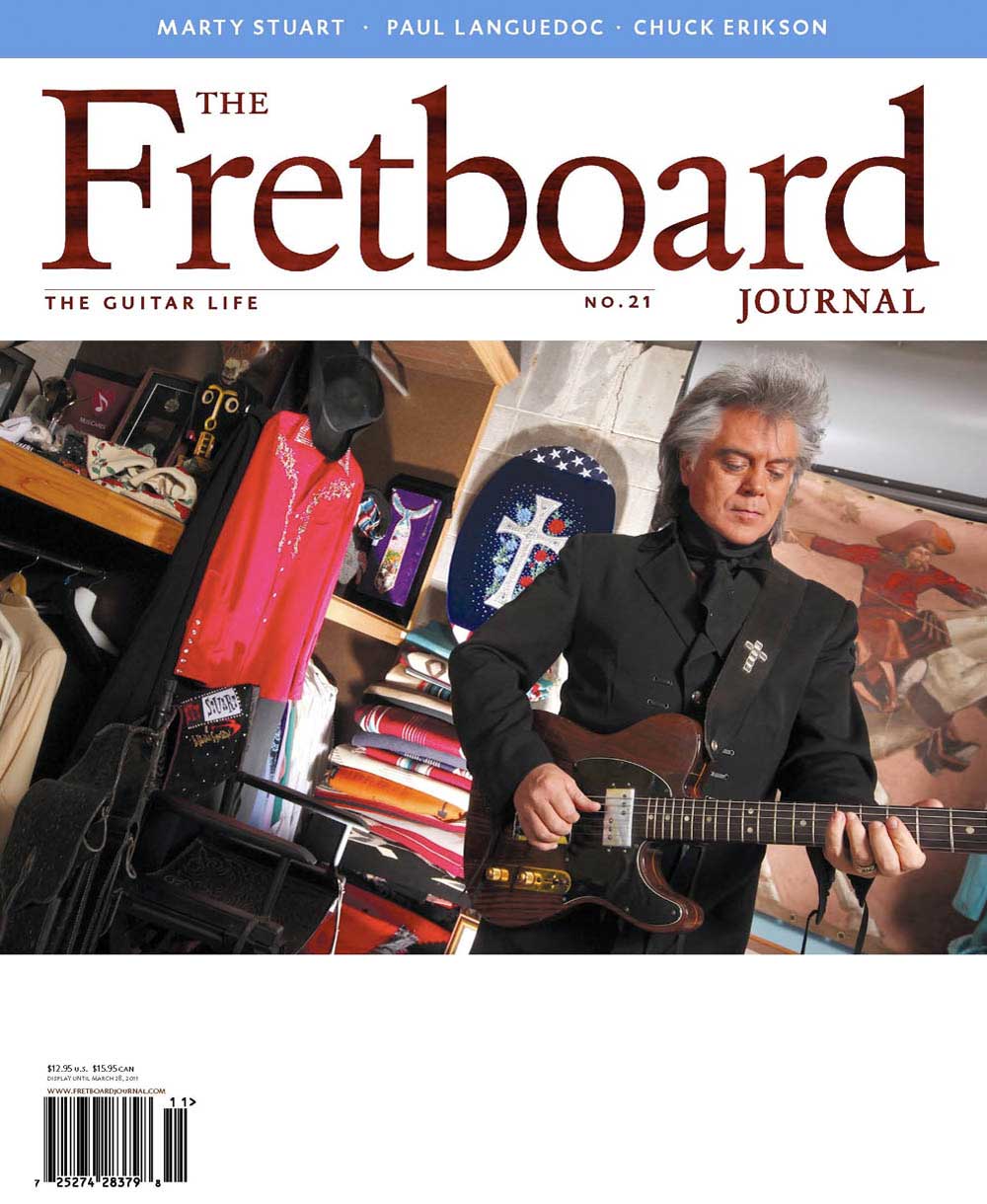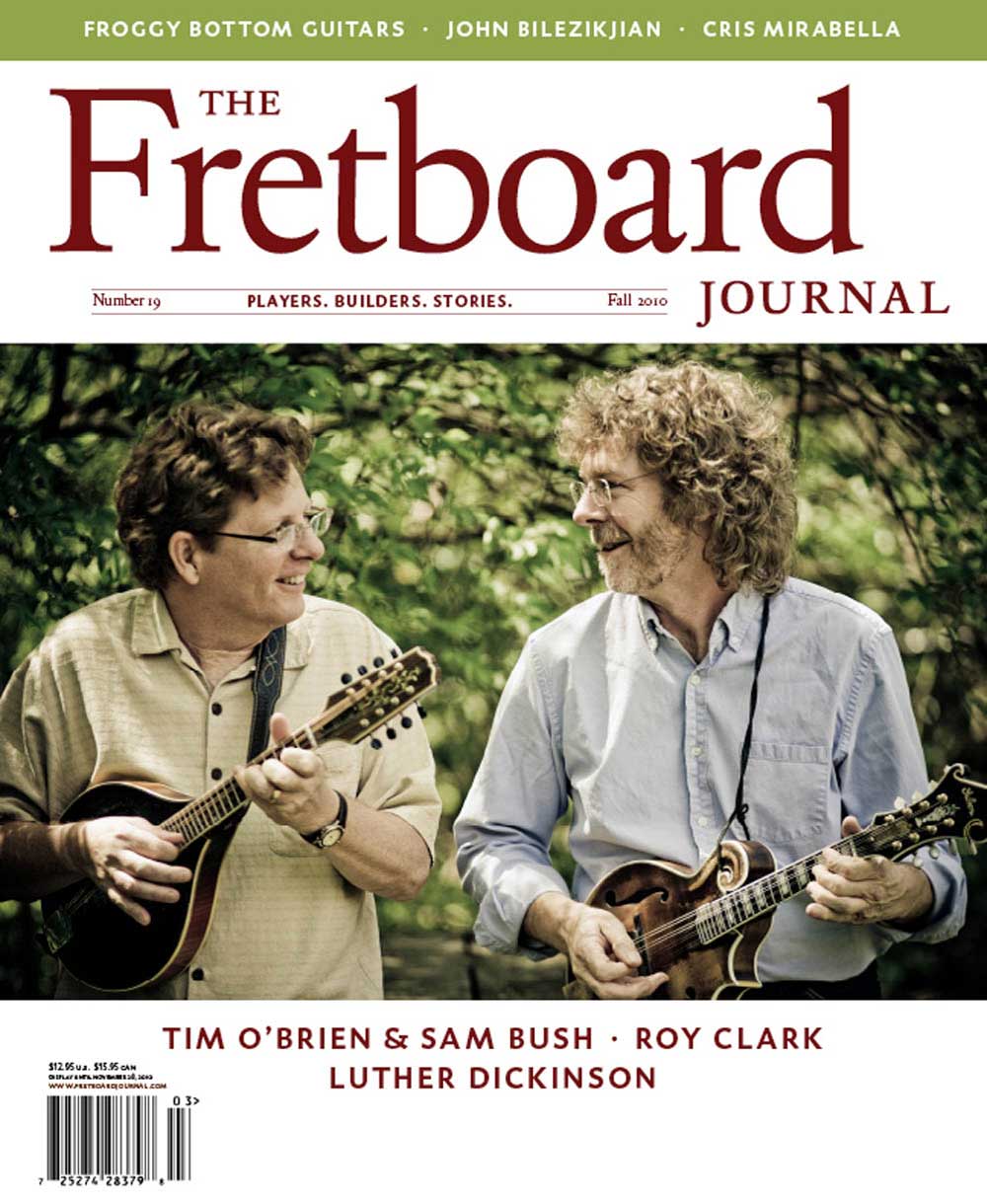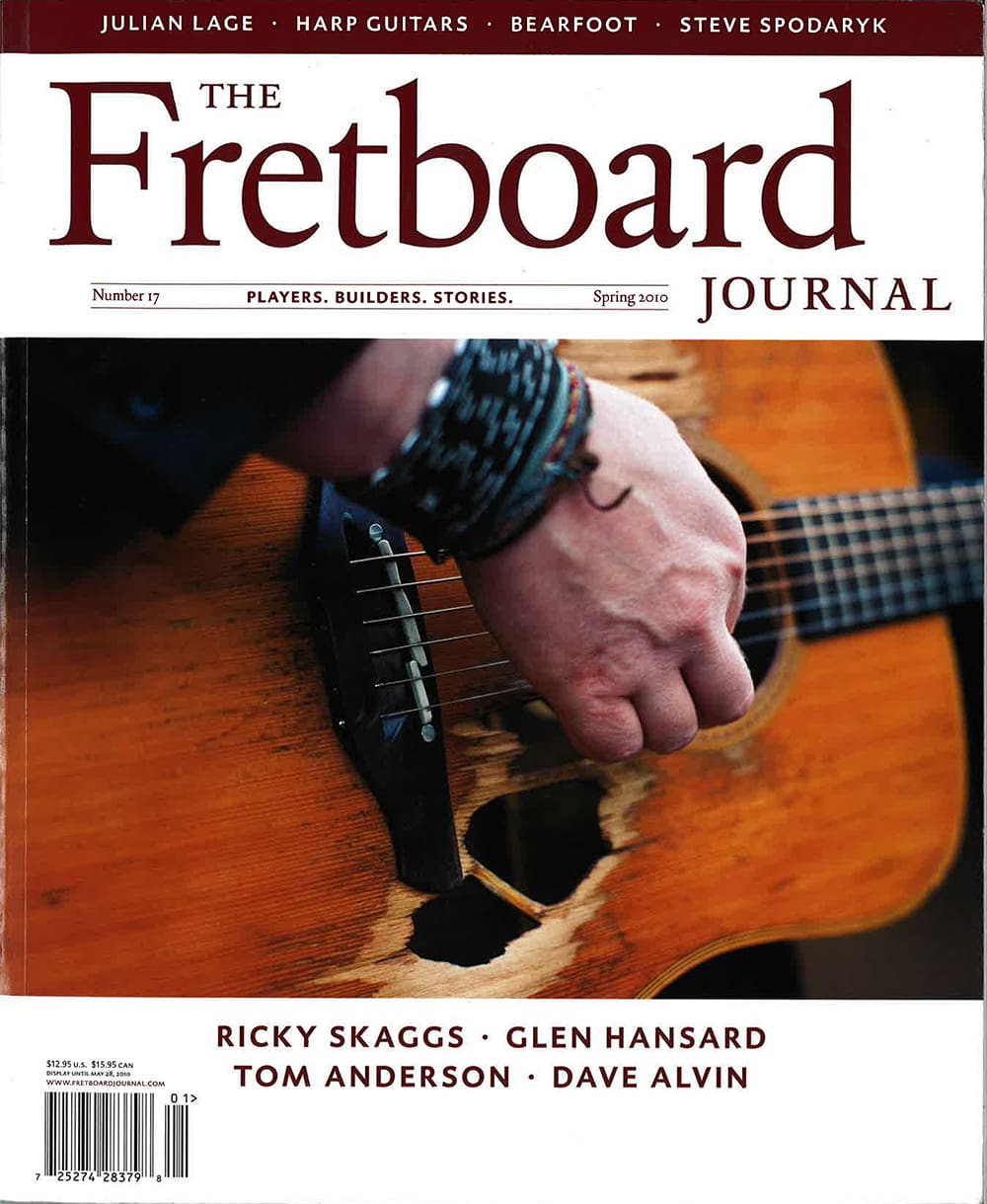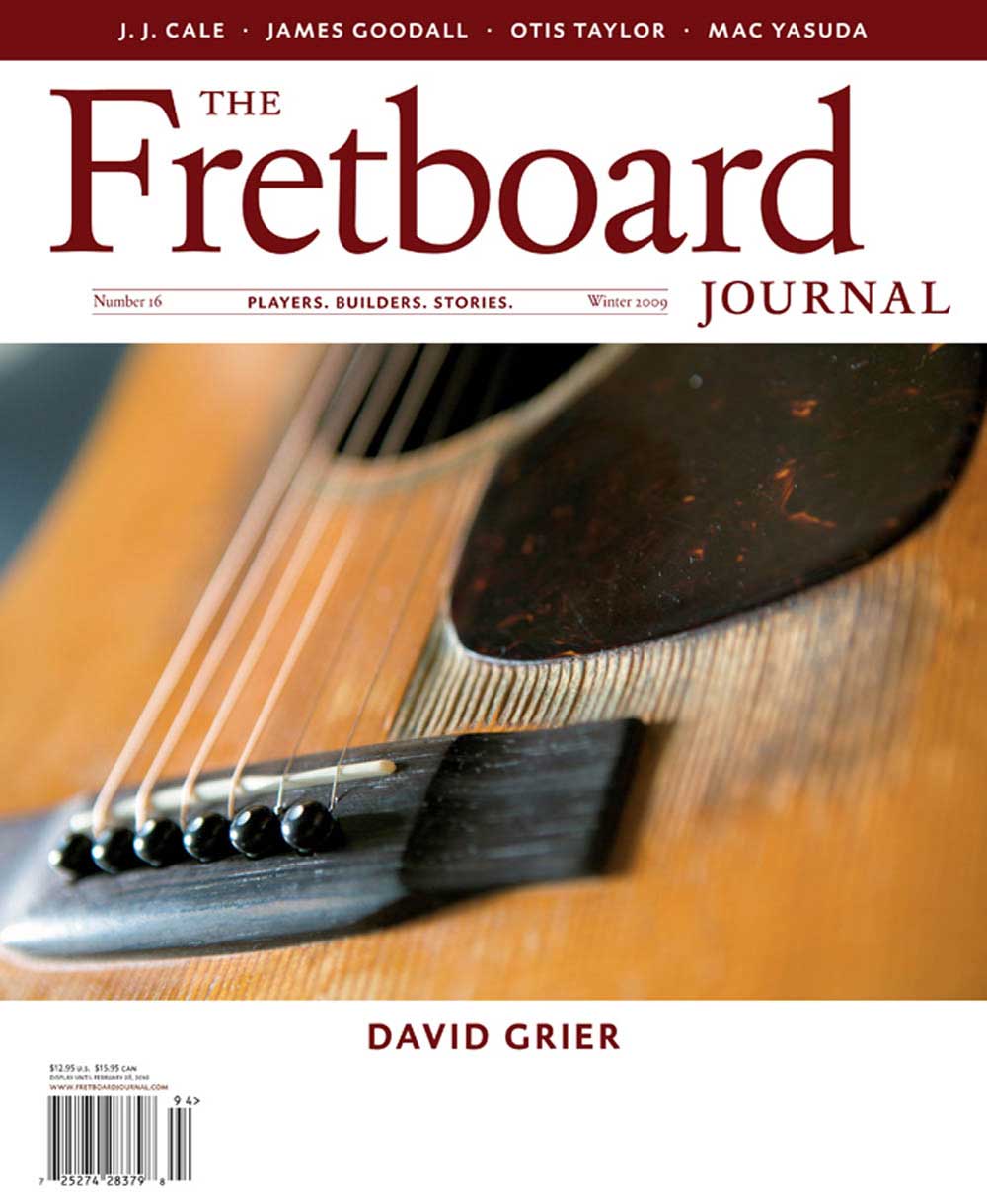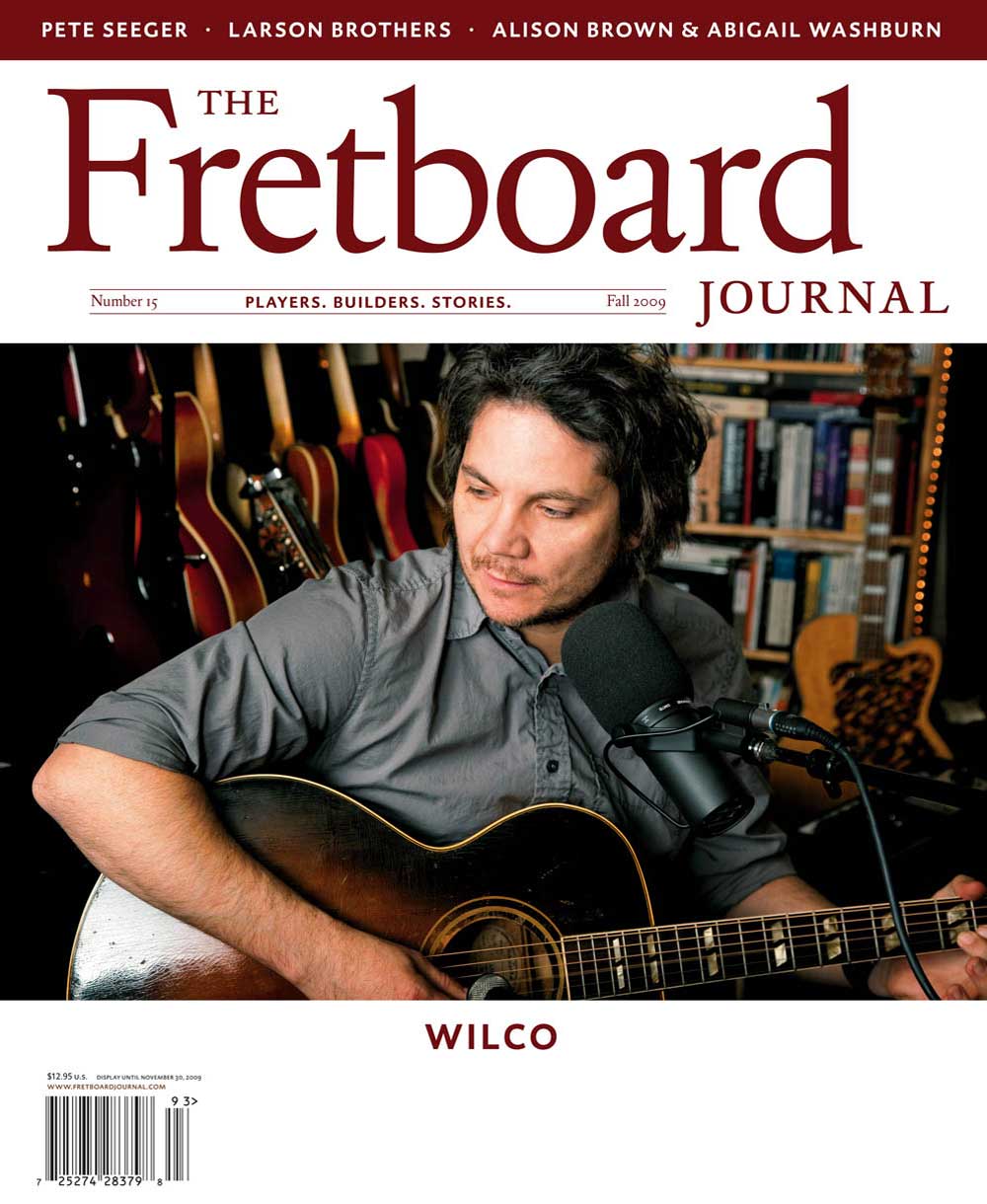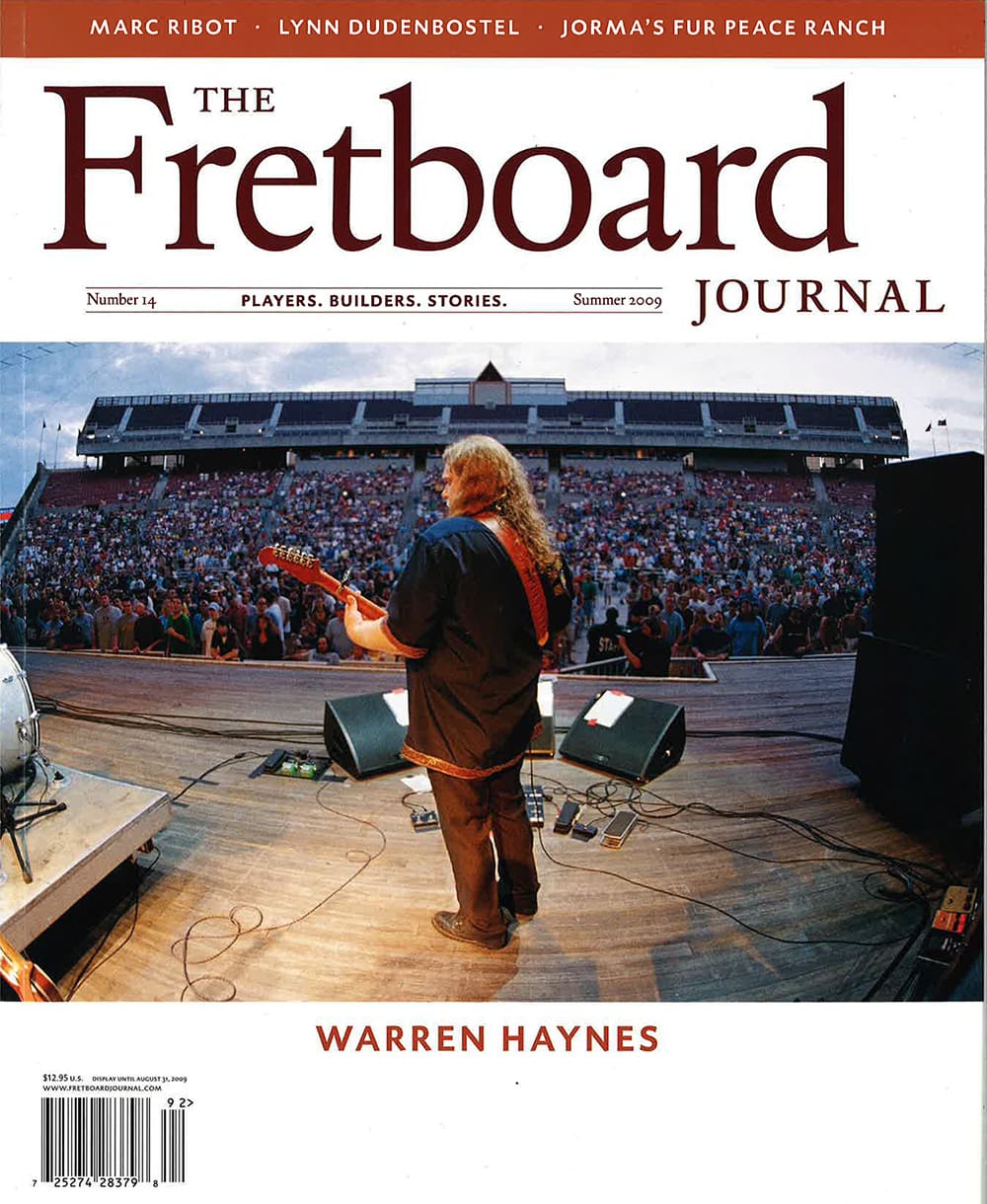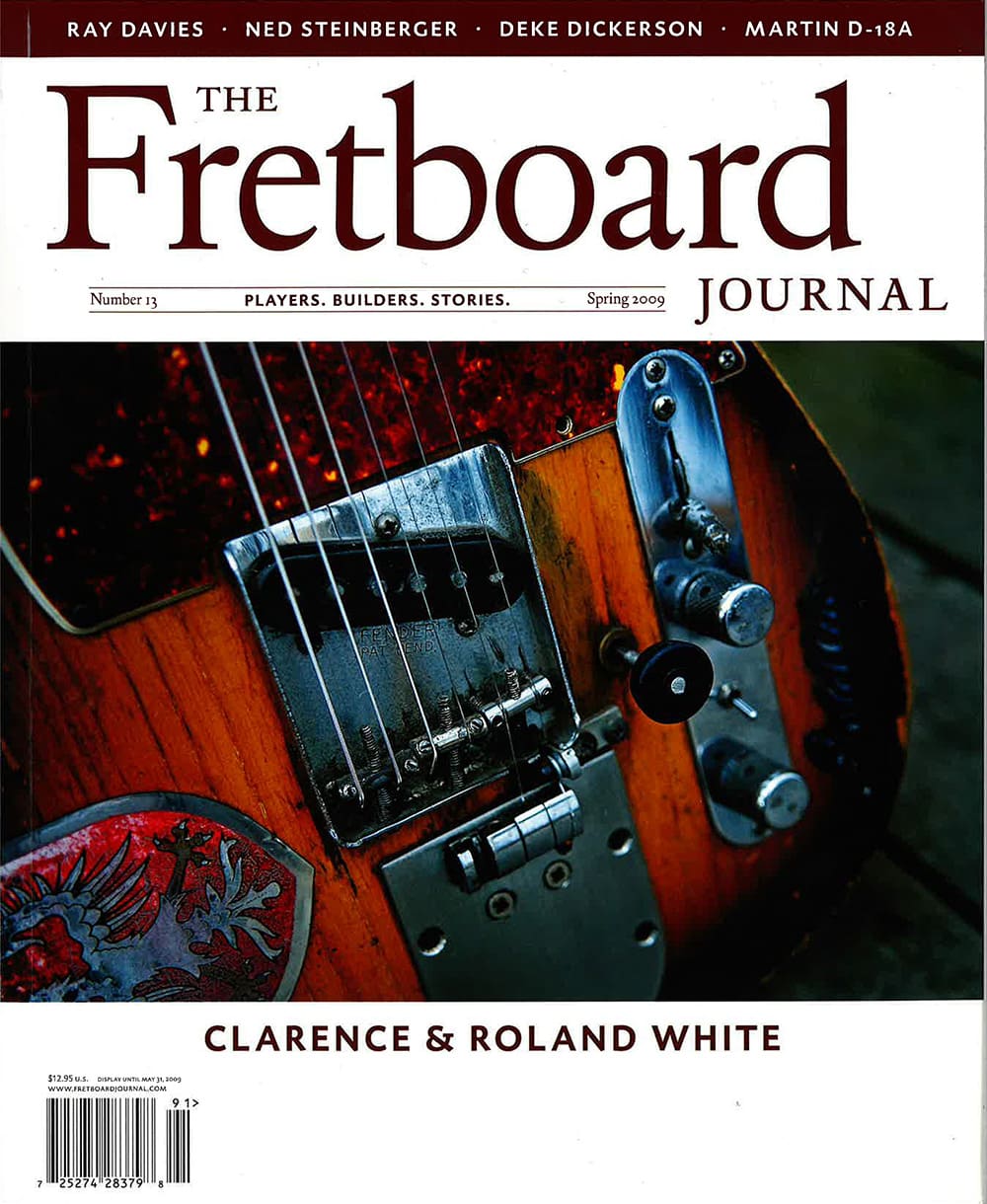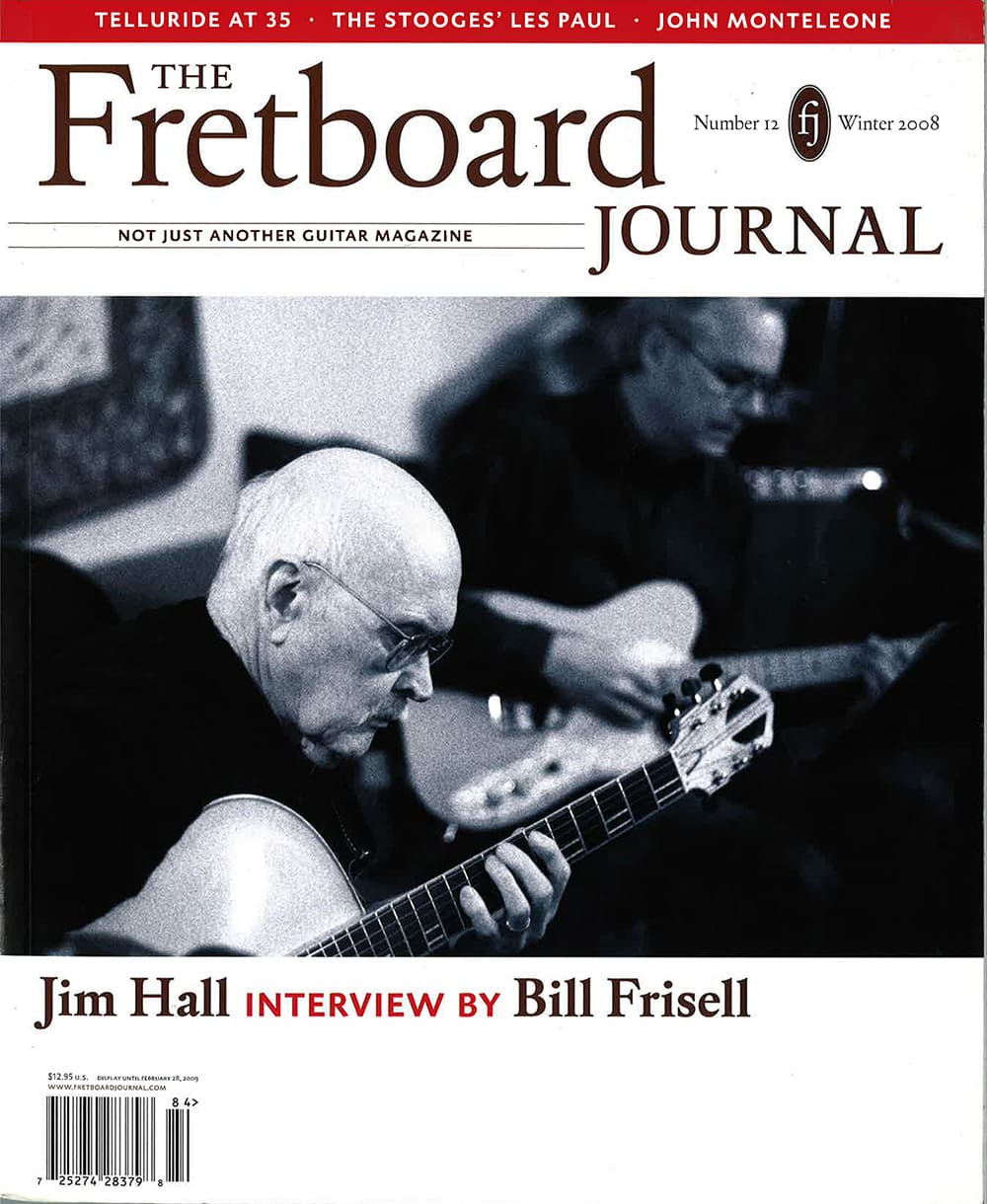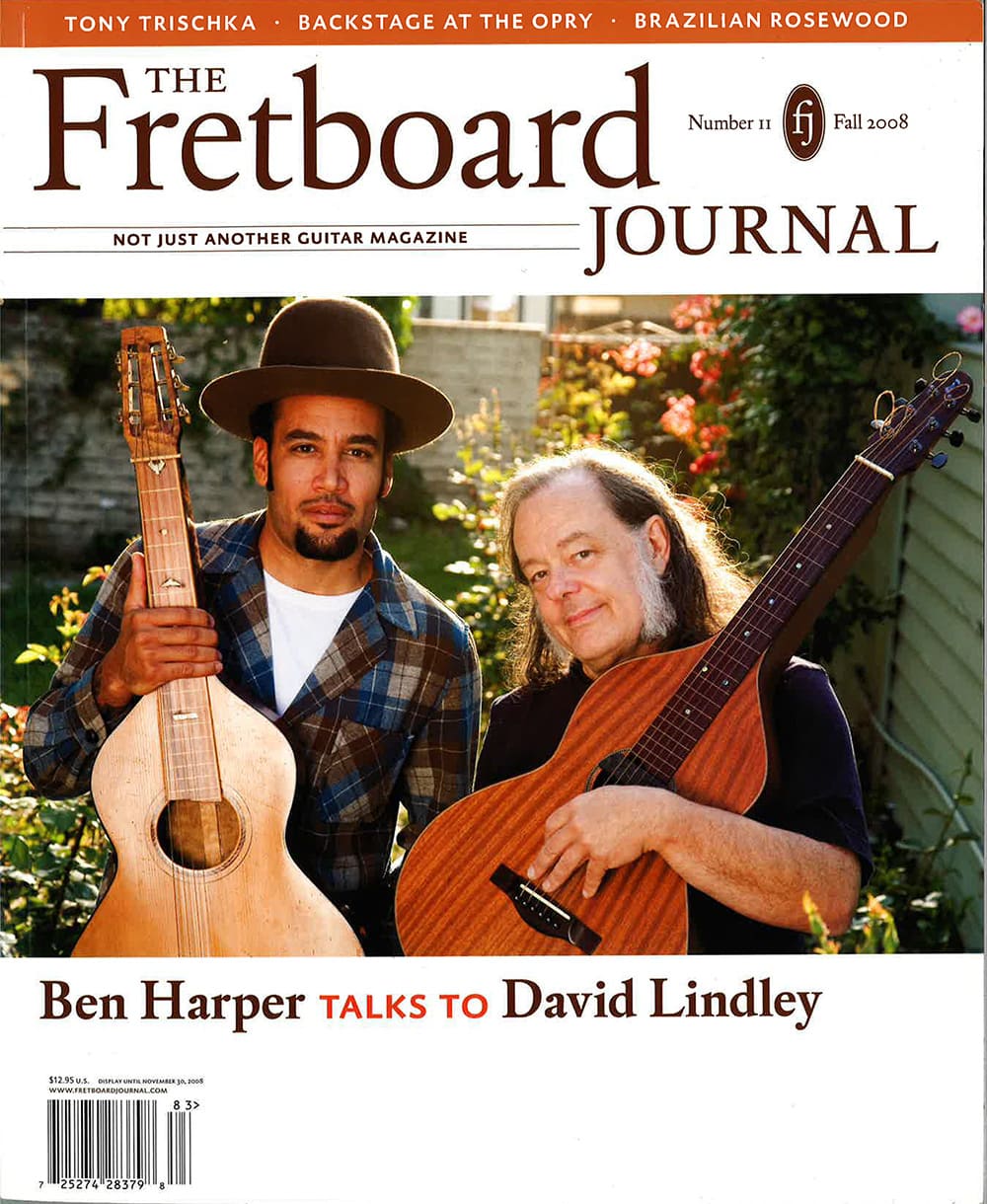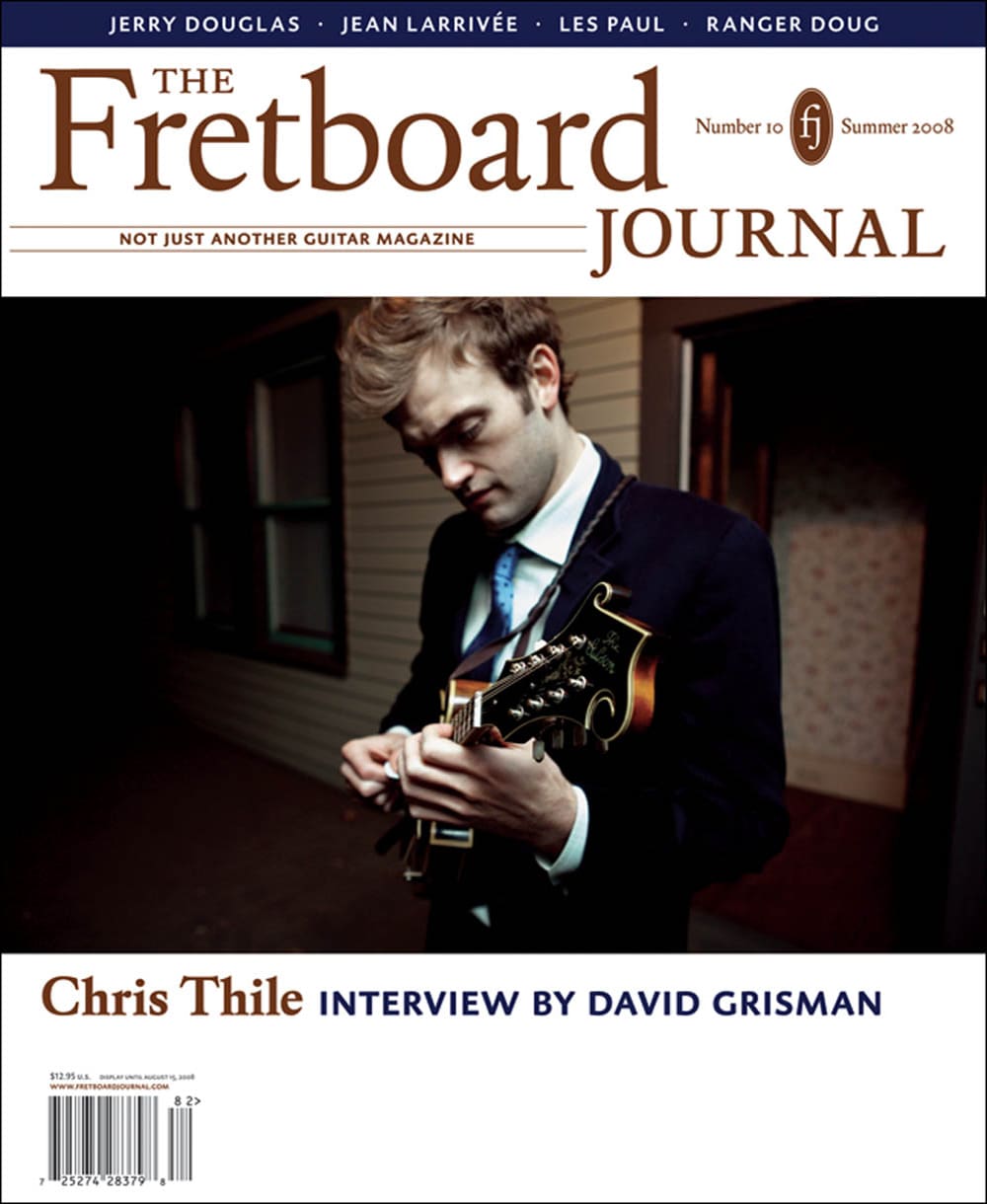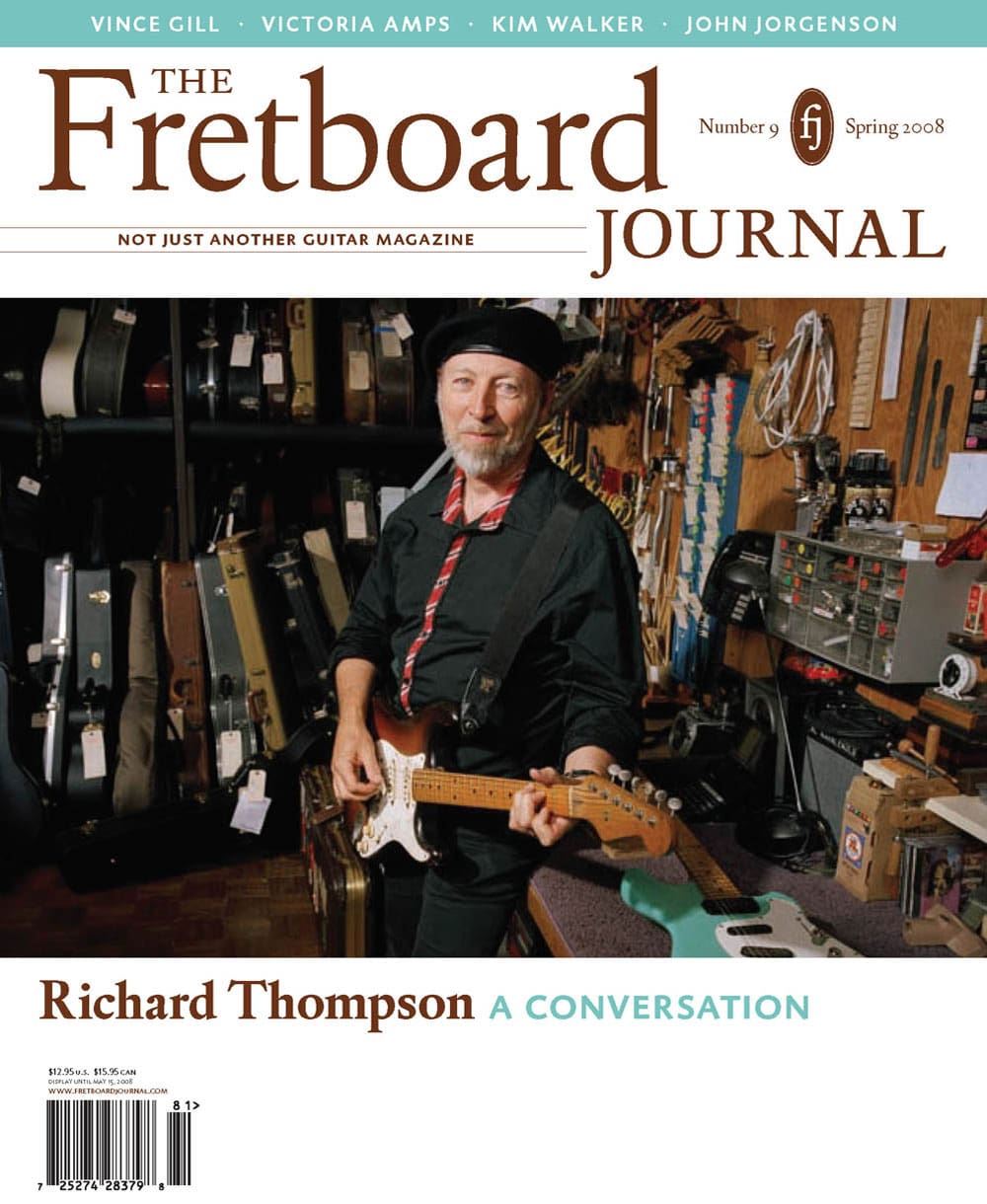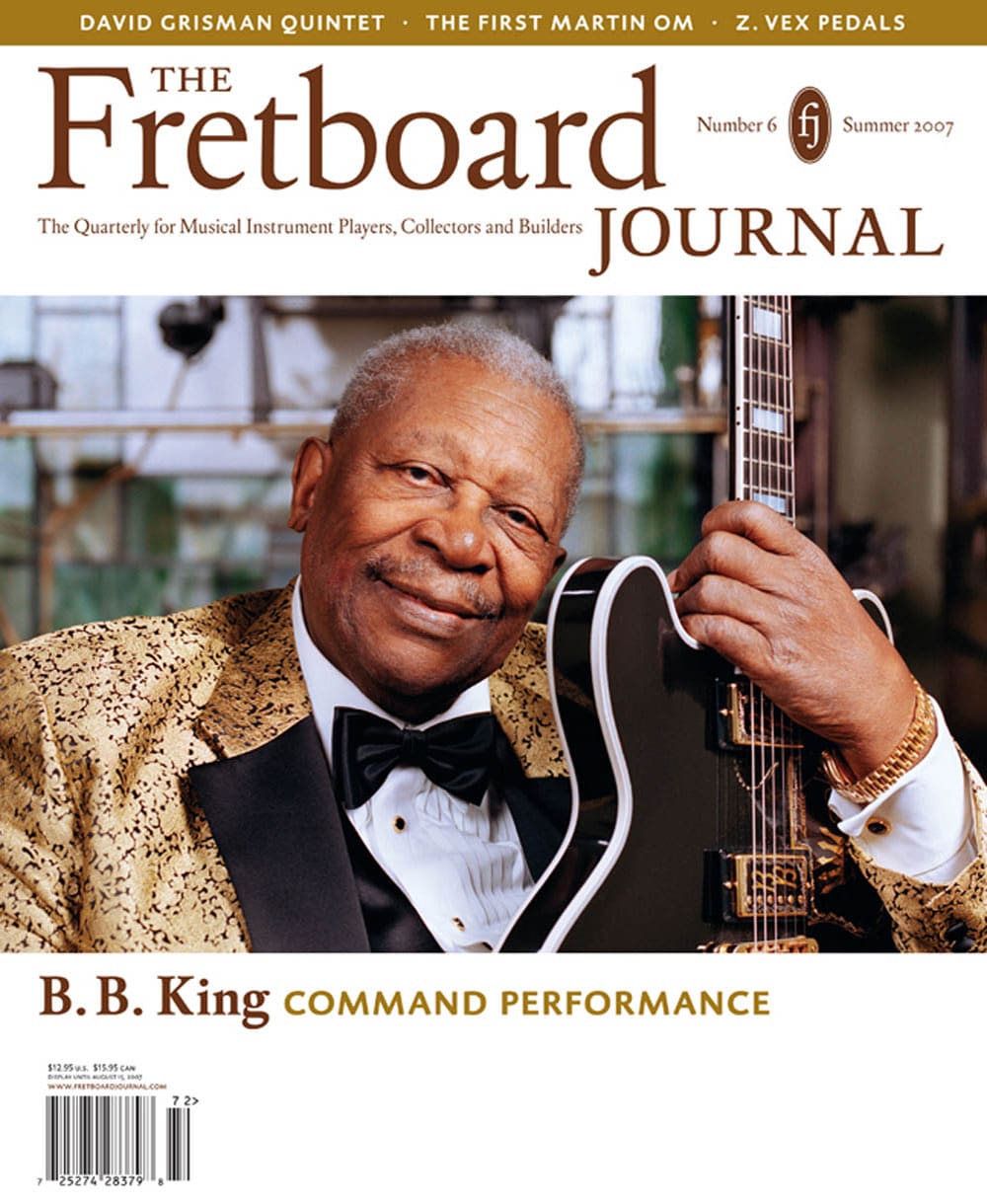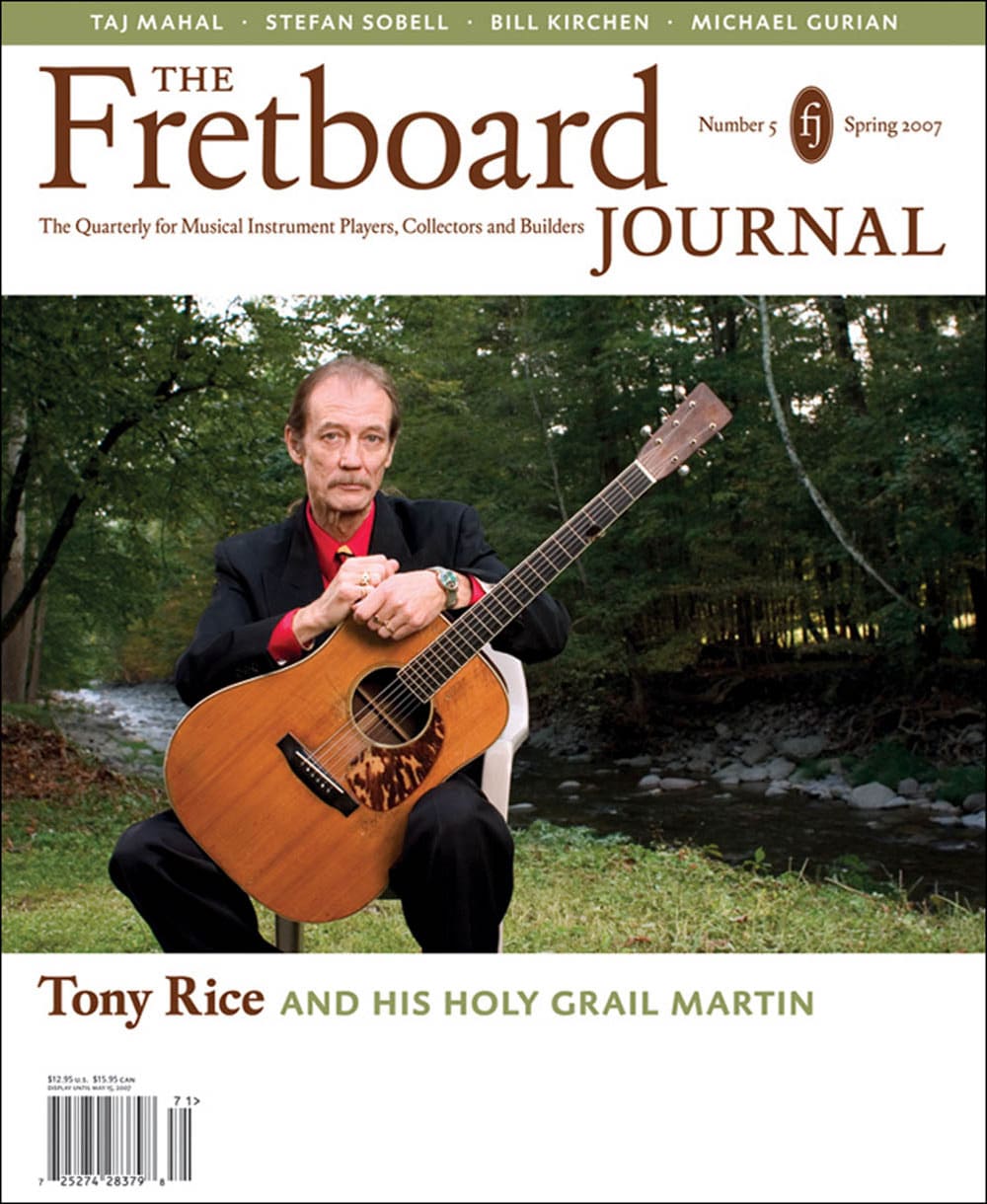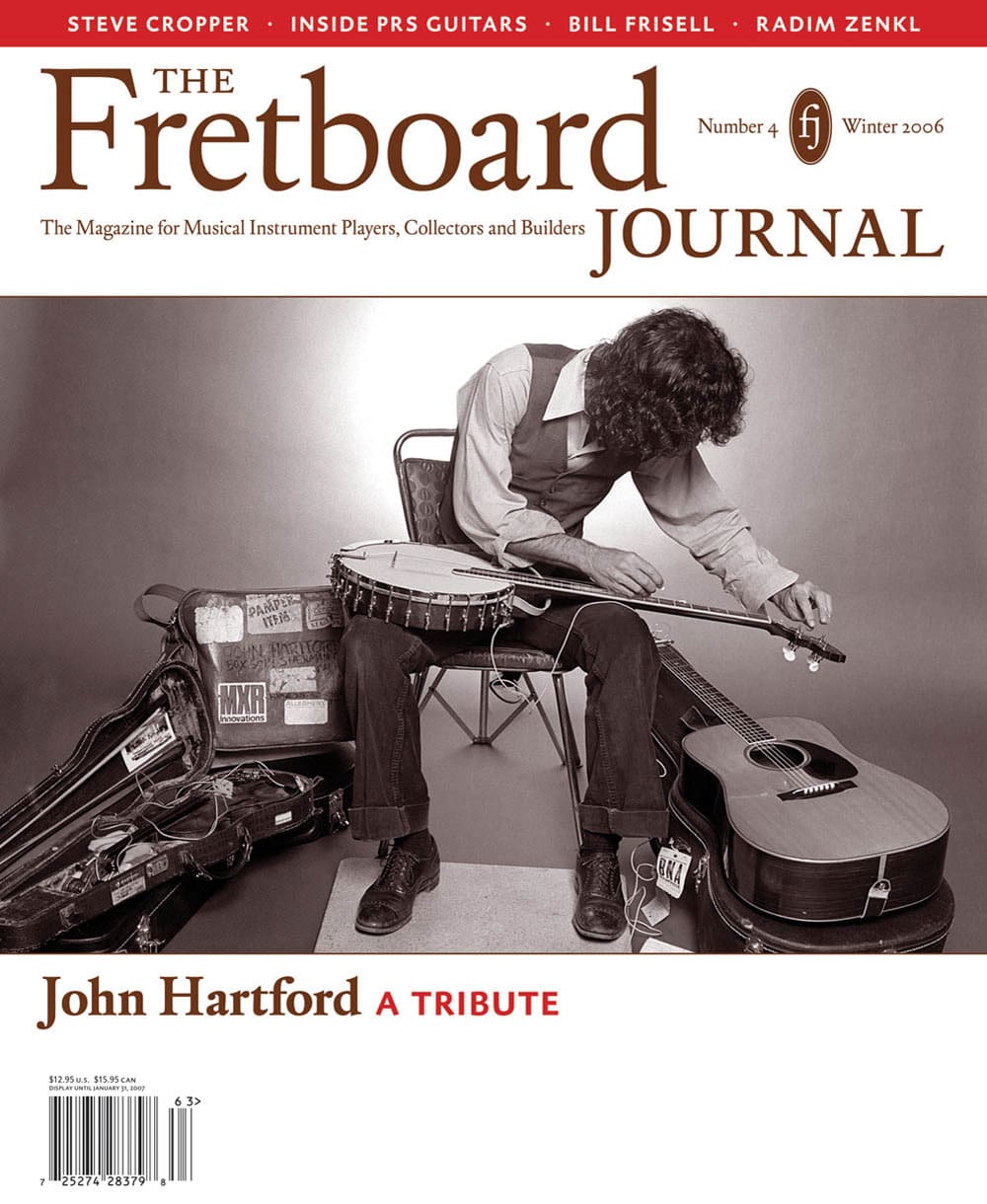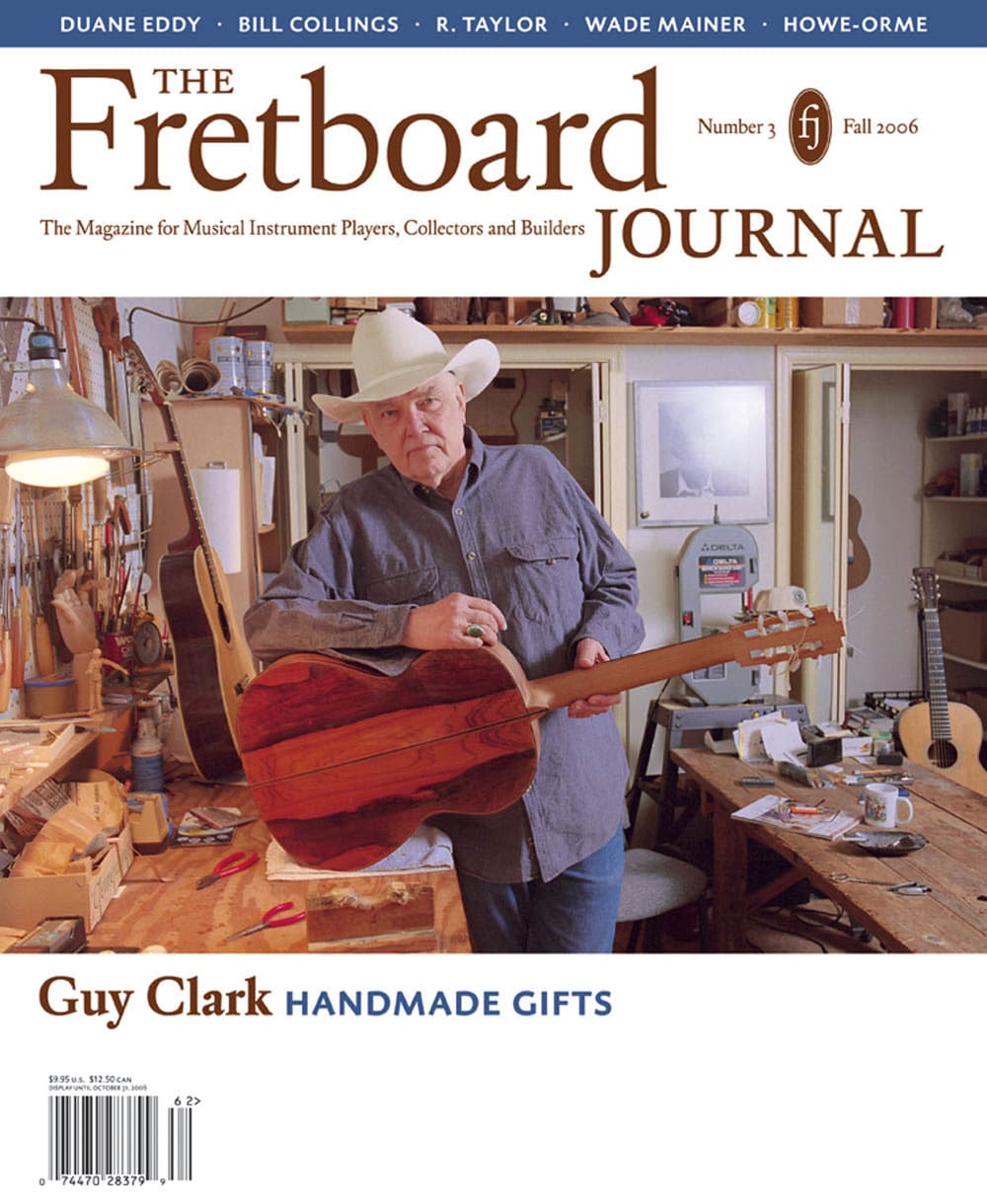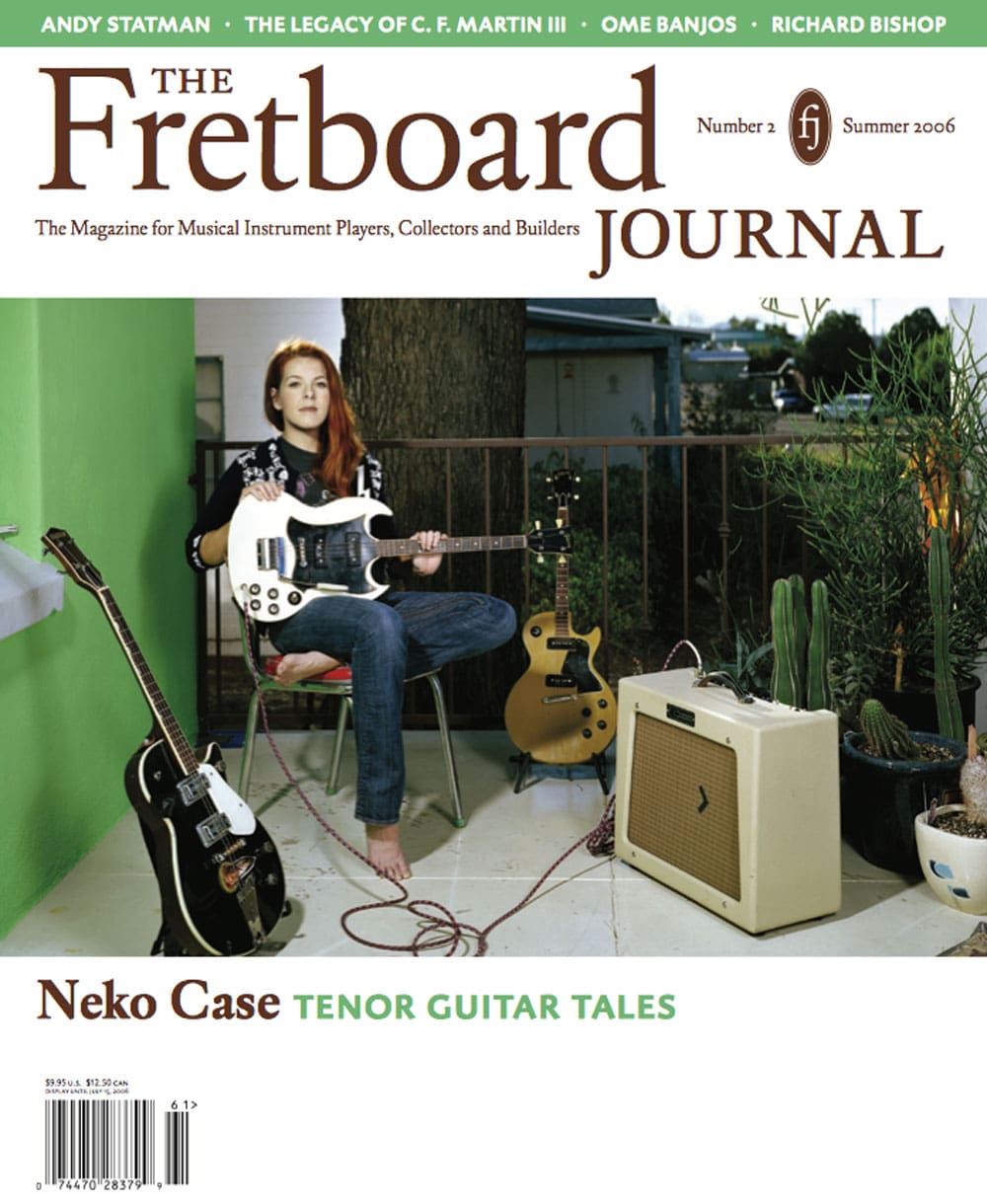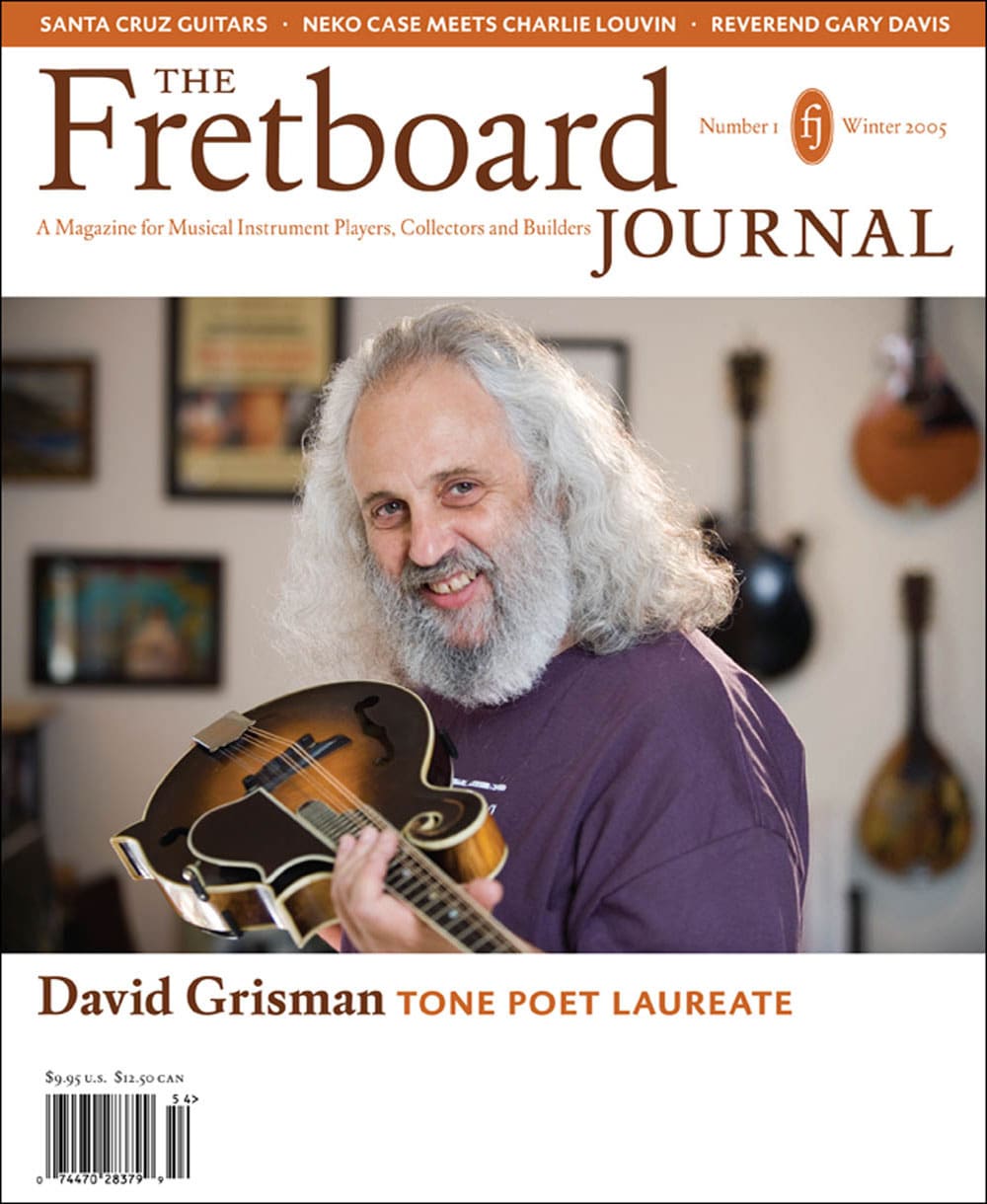Washington State Route 20 is one of the most scenic roadways in North America, running from the coast of Puget Sound up through the Skagit River Valley, and topping out at the aptly named Rainy Pass of North Cascades National Park. The area, known as “America’s Alps,” contains many splendors, among them the world’s largest Engelmann spruce trees. The world’s largest Sitka spruces lie to the west, in the temperate rain forests of the Olympic Peninsula.
It’s only fitting that along Highway 20, nestled among the Cascade Foothills, is found one of the most important businesses in the world of acoustic guitars, a specialty sawmill known as Pacific Rim Tonewoods (PRT). PRT supplies the global acoustic guitar market with precisely milled spruce guitar tops, and does it on a massive scale. Nearly 300,000 guitar soundboard blanks are produced per year, and over a million linear feet of bracewood stock. If you own and play a Taylor, Martin, Gibson, Collings, Huss and Dalton or Lowden, among many others, chances are good the spruce wood for the top was supplied by PRT.
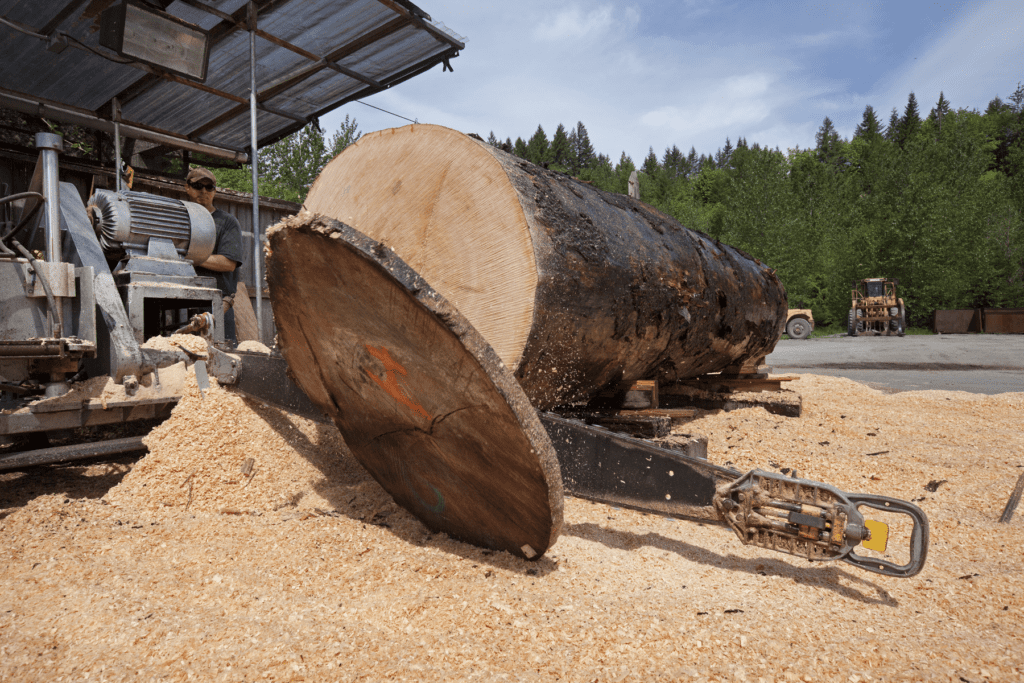
Chances are, also, that you weren’t aware of that fact until you read that last sentence. The importance of PRT to the acoustic guitar industry is in inverse proportion to its notoriety, a fact which suits founder and owner Steve McMinn just fine. Like every one of his clients, Steve started small and focused on innovation and continuous improvement to carve a niche in a competitive industry. Steve was the first wood supplier to ensure that every top out of the mill was quartersawn, painstakingly orienting each cut so that the grain lines of the wood are perpendicular to the face of the top, resulting in maximum strength, stability and tone. He was also an early adherent to the now standard practice of splitting spruce wood along the grain, following the subtle twist present in every spruce tree. This practice limits “runout,” the defect that results when imperfectly milled tops are joined at the center and reflect light in a two-toned pattern. It is safe to say that quality control decisions at PRT affect the look and sound of the entire guitar industry.
The spruce logs—Sitka, Engelmann and the Lutz hybrid—are sourced from Alaska, British Columbia and Washington State. The logging pressure is intense on these forests, and prime wood is becoming scarce. Finding it, procuring it and getting it to the mill often relies upon creativity and serendipity. My own involvement with PRT began six years ago, when I became aware of a stand of old growth Engelmann spruce slated to be cut and mulched as part of a copper mine remediation at Holden Village, a remote retreat center deep in the North Cascades. Steve McMinn is a friend and a neighbor, and I alerted him to the potential for a salvage operation for these trees. We ended up arranging, through Steve’s deep connection with Taylor Guitars, a special edition of their popular GS Mini model topped with this special Engelmann, and sold to raise money for water remediation projects in Central America. This was a worthwhile project, netting nearly $200,000 and supplying entire villages in Honduras and Nicaragua with water treatment facilities. But there was an interesting side benefit from a purely scientific standpoint: an opportunity to test the acoustic variability of wood that is closely related genetically.
Each of the trees in this beautiful alpine riverbed were about 230 years old, taking root about the time of the American Revolution, probably after a forest fire that destroyed the previous stand. Six trees were selected for this project, all of which grew within a couple-hundred yards of one another under very similar conditions. Never before had a cohort of 1,000 guitars been made out of such similar wood, under the exacting build tolerances for which the Taylor Guitar Company is justifiably famous. We reasoned that the guitars would have a similar (and signature) tone, which would be a selling point in a project where the instruments are sold directly to the customer without the benefit of guitar shop comparison.
The feedback rolled in from customers, online forums and our own direct experience. We discovered that the instruments actually sounded quite different, with variability that nearly matched that of standard models. This led us to investigate the physical properties of this wood, and further to sample the entire output of the mill so that we might understand the inherent variability of the one piece of wood on your guitar that truly matters to sound—the top.
Anyone who has ever comparison-shopped a wall of guitars knows that instruments tend to sound quite different, even guitars of the same model. That difference is rarely due to the variability in construction. Guitar manufacturing has evolved to ensure an unprecedented degree of consistency through the use of precision tooling and computerized milling, and tight quality control standards in the workshop and factory. Despite this similarity, the human ear is sufficiently sensitive to detect differences from one guitar to another, and the human brain is able to translate this information into preferences for one guitar over another when played side by side. The reason for these audible differences has primarily to do with the acoustic quality of the wood, particularly the soundboard and bracing.
The science of acoustics tells us that several physical properties are important in influencing the sound of your guitar, chief among them stiffness, density and damping. First, the stiffness to density ratio of wood must be high in order to efficiently transmit the relatively low energy of a vibrating string to a vibrating soundboard and thus radiate that energy as sound. Spruce wood in general tends to have a high stiffness to weight ratio, but our testing reveals a substantial amount of variability from top to top, up to 50 percent, even when taken from the same tree. Stiffness and density also regulate, for any given design of a guitar, the resonant frequencies at which the guitar top will vibrate most effectively and thus which notes tend to be emphasized more than others.
Damping is a little different. Damping refers to the amount of internal friction that results when wood bends, ever so slightly, as it vibrates. In general, a material with good acoustic properties has low damping. A brass bell has very low damping, for example, and a piece of wood with low damping will “ring” as you strike it, with loud and lasting tone. Damping will not, however, alter the frequencies at which it vibrates, only the intensity and the richness of the tone. The level of damping also varies from piece to piece, at least as much as stiffness and density.
None of these qualities can be seen, and indeed the visual criteria that are currently used to grade tonewood have very little to do with the acoustic properties. One can get an idea of these properties for a piece of wood by hefting it, flexing it and listening to its “tap tone.” Experienced luthiers can derive a great deal of information from these exercises and build their guitars one at a time to the wood with excellent results. The problem comes when one attempts to reliably measure and compare a large number of pieces. The best option, from a supplier’s standpoint, is to measure these properties, accurately and reliably.
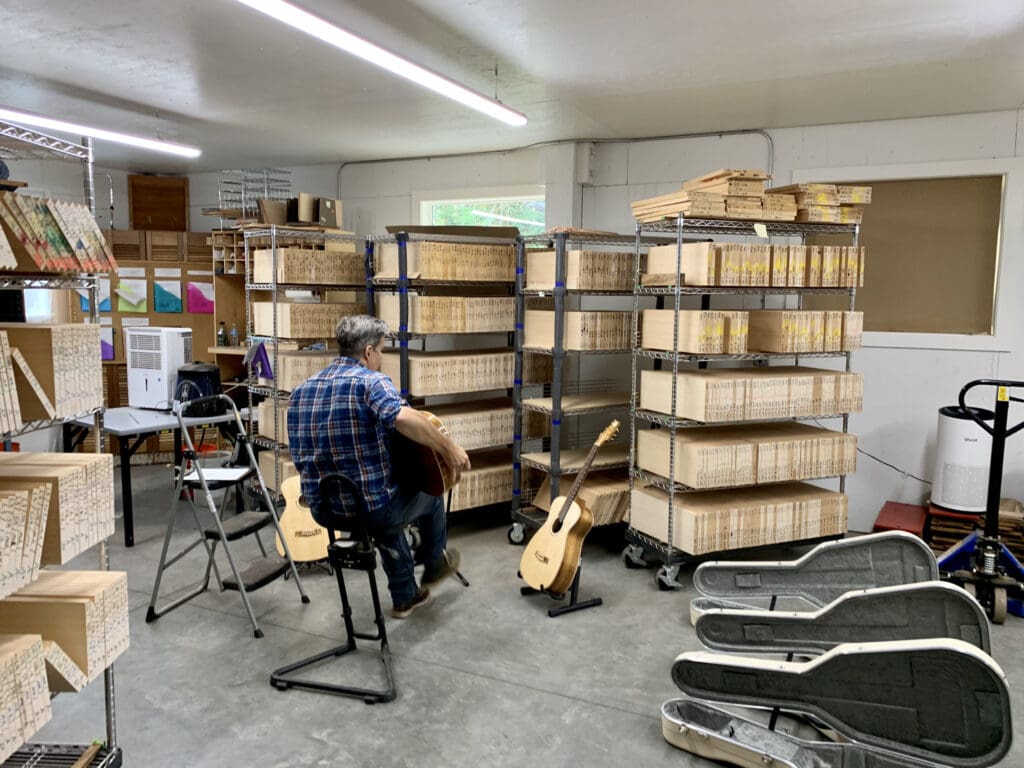
Testing, Testing, 1, 2, 3…
The methods by which we can actually take these measurements were how I really started working for PRT, turning a “one and done” project into an engaging hobby career. By day, I am an otologic surgeon, tasked with surgically treating diseases of the ear. As such, I think about acoustics every time I interact with a patient, and a love of music and musical acoustics flows organically from such work. Prior to medical school, though, I began a career in forest ecology, and ended up researching ancient spruce forests, without any thought about tonewood. I attended graduate school at a time when wood material scientists were beginning to use acoustical means to nondestructively measure properties of wood such as stiffness and strength. When I transitioned to medical school, I thought I had left that world behind.
The real world is round, however, and one never knows how a former life may rise up, dust itself off, and present itself again. When the good folks at PRT began to think of acoustically testing the output of the mill, I dug out those old research papers from the forestry department, and we jumped ahead 25 years to see who was doing the most current research. Thus began a globe-trotting search for information, tying together scientists and laboratories in France, Germany, the Netherlands, Finland, Italy and Australia, and spurring collaborative efforts in groups of very bright people who had never before worked together. In addition to the work being very interesting and a lot of fun, we have managed to make some significant contributions to the art and science of guitar making.
The first task was fairly straightforward: to measure and characterize the variability of the various species of spruce currently supplied by PRT, and to refine the processes of testing to make this efficient and economical. After extensive research, we settled on technology from the Wood Products Laboratory (CIRAD) of the University of Montpelier, France. The second task was—and is—much more complex: to answer the question “So what?” If we build instruments that vary only in the measured acoustic properties of the spruce top, does it make audible and predictable differences in the sound quality of the finished instrument? If we able to do so, and so “optimize” the sound quality of a given guitar design, then this could be a powerful tool to allow guitar makers to improve their quality and consistency. Bob Taylor put it more succinctly, after he heard a presentation of our proposal: “Guys, I don’t want to hear about why this is important, I want you to show me why this is important.”
Our challenge to Bob, graciously accepted, was to manufacture our first test instruments, and to do so by taking the unparalleled quality control for which Taylor Co. is justifiably famed and dialing it up to 11. It is a bedrock principle of science that we must carefully manipulate a limited number of test variables, and rigidly control for every other variable that could affect outcome. For our first experiment, we decided to study the variables of stiffness and density, on a flagship model at the time, the X-braced Taylor 814ce. We carefully selected five soundboard blanks from an overall pool of thousands of measured boards, and a smaller pool of boards that reflected natural range of variability of density and stiffness, but with average damping values (see below). Each soundboard blank is approximately 3/4 of an inch thick, with enough wood to make two sets of tops. We made a total of 10 guitars, two groups of five, with each guitar having a twin with an identical soundboard in the other group.
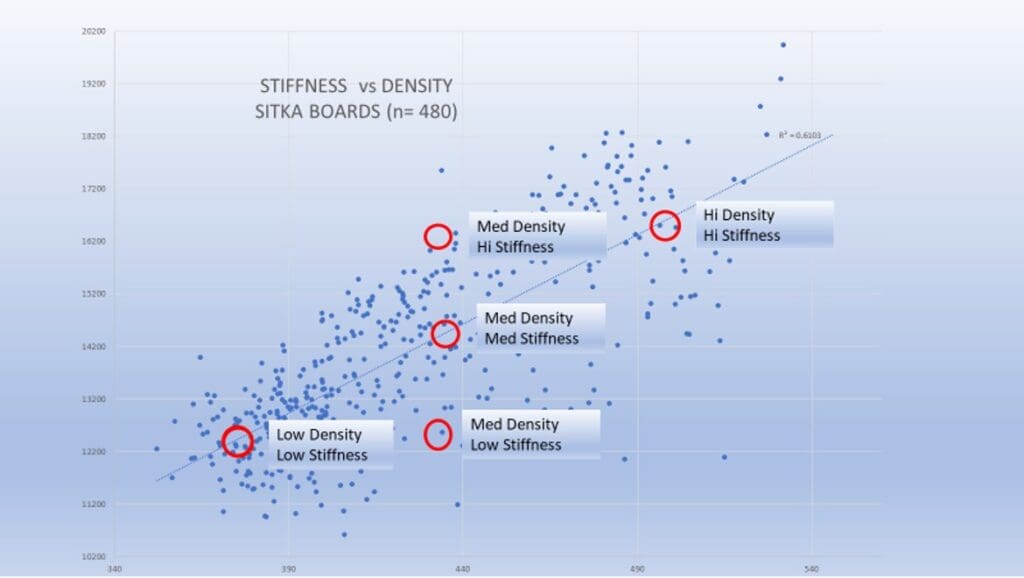
The natural variability of Sitka Spruce, in terms of Stiffness (Young’s Modulus) on the vertical axis, and Density on the horizontal axis. This represents the range of variability that is actually delivered to the guitar manufacturers by Pacific Rim Tonewoods.
We then traveled to Taylor’s climate-controlled warehouse in El Cajon and weighed hundreds of seasoned, identically shaped rosewood backs and sides, ebony bridges, grenadillo pin blocks and mahogany necks, and selected 10 sets which fell precisely on the average value for density. In other words, the spruce soundboard and bracing varied over the natural range of stiffness and density, but the other components were precisely the same. All of the 10 instruments were built on the same day sequentially, by the same team of builders. This gave an unprecedented degree of control to our experiment, ensuring that the audible differences between these instruments would be due to the acoustic qualities of the soundboard and bracing.
We engaged one of the world’s experts in guitar acoustics, Dr. Sebastian Merchel of the Technical University of Dresden, Germany, to run blinded perceptual tests of the instruments. Perceptual tests are notoriously finicky. Human sensory perception is both extraordinarily sensitive and subject to bias and fatigue, whether we are comparing fine wines or fine stringed instruments. Our challenge was to present our cadre of 23 trained listeners—an equal mixture of professional players and serious amateurs—with exactly the same sounds from each guitar, under the same conditions, and to do so in a way that would allow easy comparisons.

The research team in the anechoic chamber at the Technical University of Dresden; author David Olson is second from left.
Earlier tests have demonstrated that this is an extremely difficult task. The noted musical acoustician Dr. Claudia Fritz, for example, published a series of studies comparing Stradivari violins to modern elite instruments. These tests showed us that even live performances in a concert hall are flawed, in that the auditory experience varies enough seat to seat to affect the ability to perceive subtle differences in tone. Sebastian’s solution to this dilemma was elegant and unprecedented in perceptual research: the use of an anechoic chamber to make recordings that are indistinguishable from live performance. Dresden Technical University has one of the most acoustically perfect anechoic chambers in Europe, a room the size of a small cathedral in which the floor, walls and ceiling are lined with two-meter-long foam wedges that effectively cancel any sound reflection but allow the sound from the instrument to be heard and recorded perfectly. We spent a couple of days in that chamber making carefully controlled recordings with a single professional player. Importantly, this removed the effect of the room from the recording, an effect which homogenizes tone and is why we can always tell the difference between live and Memorex.
Until now, that is. The recordings made in the anechoic chamber were played back under precise conditions in Dresden Tech’s Multi-Modal Measurement Laboratory, an acoustics laboratory lined with 360 speakers in the floor, walls and ceiling. This “3 Million Euro” room is typically used to test automotive acoustics and is funded by a consortium of German automobile manufacturers. Using this ultra-sophisticated auditory space and retooling it to test musical acoustics, our recordings were indistinguishable from live performance by professional acousticians under blinded conditions.
We then used the technique of sequential pairwise comparison, pairing short snippets of recordings from each guitar with those from a different guitar, until we had “A/B” comparisons with each pairing. Each listener went through the pairings one by one in the same chair in the laboratory, and was asked to choose a preferred guitar in each pairing. The pairings were then statistically compared, and an overall ranking was determined for each group of five guitars.
The results were extraordinary. When we ran the pairwise comparison ranking of the first set of five instruments, we found that the guitar with the lowest density and stiffness top was the preferred guitar, with the ranking running in a continuous line from low to high density and stiffness. The differences reached statistical significance, a rarity in perceptual research, and an indication that we were on to a real effect here. When we ran the second group of five guitars, built with twin soundboards to the first group, we found exactly the same ranking, with the lowest-density top preferred. While this may seem unsurprising, recall that the tests were done entirely blind. The listeners were simply given short snippets of recorded music and asked to choose between the snippets, without any other context. The rankings are statistically derived, eliminating all possibility of bias. The chances that such a ranking would occur twice by chance is small enough as to be practically impossible. Thus, for this particular guitar model, the Taylor 814 Grand Auditorium, we can unequivocally state that we are able to reliably and repeatedly optimize its sound quality by careful selection of the acoustic quality of the soundboard wood.
There is a coda to the story, a parallel test of this group of guitars that was less scientific but no less important. Prior to shipping the newly built guitars to Germany, a “player’s test” of the instruments was performed with the leading players from the factory. The 10 players weren’t informed of the nature of the experiment, but were simply asked to rank each group of five, using their extensive experience with these instruments to judge the overall tone and apply their own personal preference. The results in each specific case were diverse, but in aggregate the player’s test approximated the later listening test results. But no player exactly replicated the precise ranking of the larger experiment—with one notable exception. Master builder Andy Powers, the luthier most responsible for the modern Taylor sound, ranked the guitars in each group in exactly the same order as the Dresden test would months later and nine time zones away. Again, Andy had no other information to do so than the tone that resulted from his own playing and discernment. His comments on each guitar are a telling summation of the importance of soundboard optimization. The low density/low stiffness guitars are described as “more lively, with harmonic bloom and power in the high notes.” The highest-stiffness guitars are “more muted…sounds stiff.” The guitar in the middle of the density and stiffness scale was described, on the sole basis of its tone, as “middle of the spectrum, with good low end and crispy trebles.”
The results of this study apply most specifically to this particular model, with this particular design. Not every guitar, of course, would necessarily benefit from the same low-density wood. It does stand to reason, however, that each guitar design has a particular suite of acoustic qualities of the soundboard that will result in a sound that most listeners and players will find most pleasing. Our efforts continue, with a couple of experiments underway in Dresden and Australia that flip this experiment on its head by varying damping and controlling stiffness and density. Early results suggest outcomes that are equally interesting and encouraging.
For centuries, luthiers have struggled with the natural variability of soundboard wood, and have adapted by modifying the design characteristics to “build to the wood.” Now for the first time, we can accurately quantify the relevant acoustic properties of the soundboard and bracing, and thus grade tonewood by the criteria that will allow the optimal tonal quality. Ultimately, we hope that luthiers will be able to take advantage of this consistency to influence their designs, with assurance in the reliability of the resulting sound for the next guitar they build, or the next thousand. In so doing, we will be able to take advantage of the wonderful diversity that nature gives us, instead of being limited by it.
This article originally appeared in Fretboard Journal 48.












